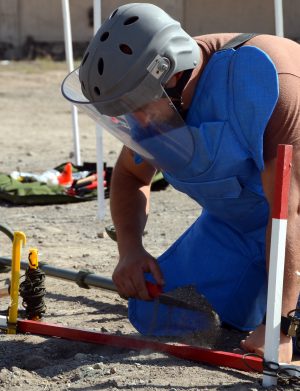In 2000, Uzbekistan began placing landmines along the mountainous portions of its partially undemarcated border with Tajikistan and Kyrgyzstan. The mines, placed to deter terrorists, turned a difficult border deadly — and not necessarily for the intended targets, the Islamic Movement of Uzbekistan (IMU).
According to the Tajik side, in nearly 20 years 374 Tajik citizens were killed by anti-personnel mines, a further 485 injured.
On January 3, Tajik news websites Asia Plus cited a Tajik security source saying that Uzbekistan had completed mine-removal activities along the border. The Uzbek side, according to the source, refused Tajik assistance given that the clearing activities were on Uzbek territory.
When the mines were laid, the exact placement of the border was in dispute. Progress on border delimitation had been slow until 2016, when new Uzbek President Shavkat Mirziyoyev made it a priority to improve Tashkent’s relations with the rest of Central Asia. His presidency notched a steady stream of improvements in the bilateral relationship with Tajikistan, propelled by a March 2018 visit by Mirziyoyev to Dushanbe followed by an August 2018 visit by Tajik President Emomali Rahmon to Tashkent. Rahmon’s trip to Uzbekistan was his first in 17 years. These visits did more than alter perceptions; they had measurable impact as border crossings were reopened and visa rules relaxed.
Reinvigorated bilateral work on the border has led to news this week not only that the demining work has been completed, but that the Uzbek and Tajik sides are moving forward from delimiting their border to demarcation. As reported by Trend, the Joint Uzbek-Tajik Demarcation Commission met for the first time in Tashkent this week. A protocol was signed and the schedule to meetings for 2020 set.
In January 2018, one of the more contentious sections — around the Farkhad Dam — was settled. As I wrote at the time: “The dam, located on the Tajik-Uzbek border where Tajikistan’s Sughd region meets Uzbekistan’s Sirdaryo region, was completed in 1949. The dam and its facilities have been contested territory since independence.”
The agreement recognized the land around the dam as Tajik territory but the dam itself as Uzbekistan’s property. Site security responsibilities would fall to Tajikistan while operations would be managed by Uzbek engineers.
There are likely to be some further difficulties as the delimited, discussed border is put down on maps and marked on the ground. But it’s worth noting how close Uzbekistan and Tajikistan are to settling the border issue, and how far they’ve come down that path.
Keep in mind that back in 2004, an Uzbek government official claimed to have begun demining of the border area. People continued to occasionally die in blasts and Uzbek officials expressed little to no interest in the issue. As Bruce Pannier recollected in an October 2018 article:
In November 2009, Uzbek Ambassador to Tajikistan Shokosim Shoislomov said his country had no intention of removing the land mines or of giving Tajikistan maps of where the land mines were laid. “These mines in mountains do not affect anybody, and there is nothing to do for a normal person in such remote places,” Shoislomov said. “Only those who want to cross the border illegally are going there. It is these people against whom mines were planted at certain sections of our border with Tajikistan.”
In October 2018, Uzbek officials once again announced the start of demining work, with the goal being the clearing of the Tajik-Uzbek border of mines by the end of 2019. This week’s news is long awaited good news.

































